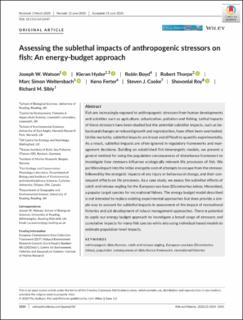| dc.description.abstract | Fish are increasingly exposed to anthropogenic stressors from human developments and activities such as agriculture, urbanization, pollution and fishing. Lethal impacts of these stressors have been studied but the potential sublethal impacts, such as behavioural changes or reduced growth and reproduction, have often been overlooked. Unlike mortality, sublethal impacts are broad and difficult to quantify experimentally. As a result, sublethal impacts are often ignored in regulatory frameworks and management decisions. Building on established fish bioenergetic models, we present a general method for using the population consequences of disturbance framework to investigate how stressors influence ecologically relevant life processes of fish. We partition impact into the initial energetic cost of attempts to escape from the stressor, followed by the energetic impacts of any injury or behavioural change, and their consequent effects on life processes. As a case study, we assess the sublethal effects of catch and release angling for the European sea bass (Dicentrachus labrax, Moronidae), a popular target species for recreational fishers. The energy budget model described is not intended to replace existing experimental approaches but does provide a simple way to account for sublethal impacts in assessment of the impact of recreational fisheries and aid development of robust management approaches. There is potential to apply our energy budget approach to investigate a broad range of stressors and cumulative impacts for many fish species while also using individual‐based models to estimate population‐level impacts. | en_US |
